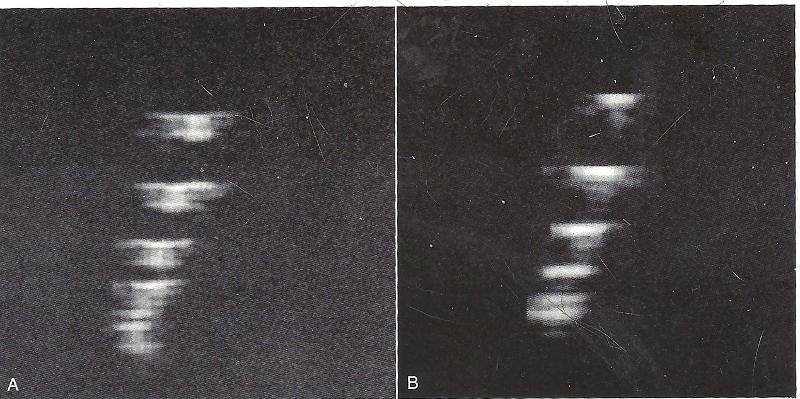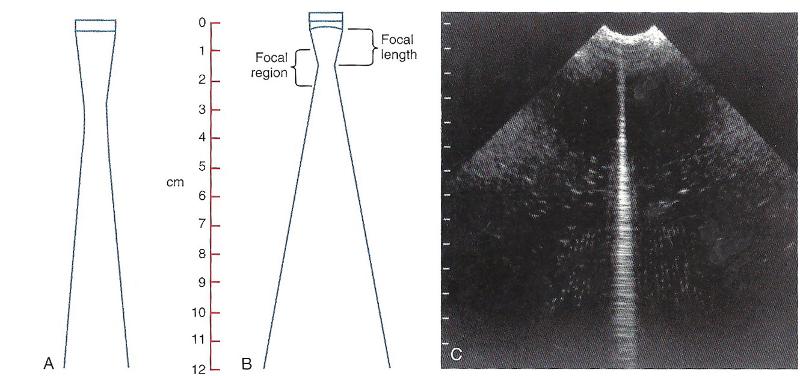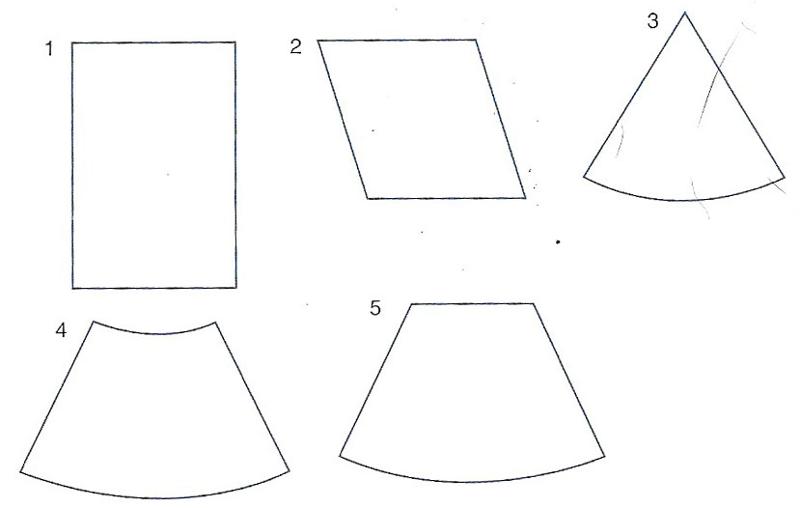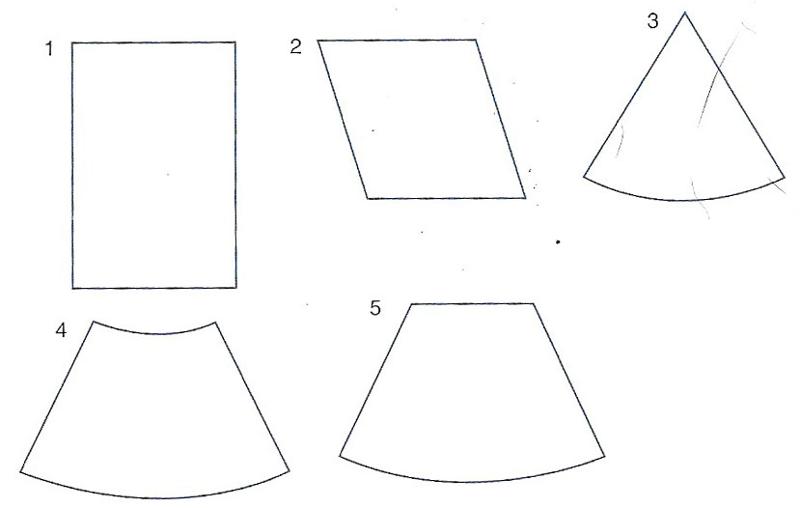A transducer converts one form of ______________ to another.
Energy
Ultrasound transducers convert ________________ energy into ____________ energy, and vise versa
Electric, ultrasounf
Ultrasound transducers operate on the ______________ principle.
Piezoelectric
Single-element transducers are in the form of ____________.
Disks
The ___________ of a transducer element changes when voltage is applied to its faces.
Thickness
The term transducer is used to refer to a transducer __________ or to a transducer ______________.
Element, assembly
A transducer _________________ is part of a transducer _________________.
Element, assembly
An electrical voltage pulse, when applied to a transducer, produces an ultrasound _____________ of a _____________ that is equal to that of the voltage pulse.
Pulse, frequency
The resonance frequency of an element is determined by by its ______________.
Thickness
Operating frequency ______________ as transducer element thickness is increased.
Decreases
The addition of damping material reduces the number of ___________ in the pulse, thus improving ___________ __________. It increases ______________.
Cycles, axial resolution, bandwidth
Damping material reduces the _____________ of the transducer and _______________ _______________. It increases _______________.
Efficiency, sensitivity
Ultrasound transducers typically generate pulses of ___________ or _____________ cycles.
Two, three
For a particular transducer element material, if a thickness of .4 mm yields an operating frequency of 5 MHz, the thickness required for an operating frequency of 10 MHz is ________________ mm.
.2 mm
.4 mm / 2= .2 mm
Which of the following transducer frequencies would have the thinnest element?
A) 2 MHz
B) 3 MHz
C) 5 MHz
D) 7 MHz
E) 10 MHz
E) 10 MHz
The matching layer on the transducer surface reduces _________ caused by _____________.
reflection
A coupling agent on the skin surface eliminates reflection caused by _______________.
air
True or False?
Damping lengthens the pulse.
False
True or False?
Damping increases efficiency.
False
The damping layer is in front or back of the element.
Back
The matching layer is in front or back of the element.
Front
The matching layer has ___________ impedance
intermediate
Elements in linear arrays are in the form of _____________.
rectangles
Transducer assemblies are also called ___________.
A) transducers
B) probes
C) scanheads
D) scan converters
E) skinheads
F) more than one of the above
F) more than one of the above
A) transducers
B) probes
C) scanheads
Operating frequency is also called ________.
resonance frequency
Mixtures of a piezoelectric ceramic and a non-piezoelectric polymer are called _______________.
composites
To operate a transducer at more than one frequency requires ______________ _____________.
broad bandwidth
It is practical to attempt to operate a 5-MHz transducer with a bandwidth of 1 MHz at 6 MHz?
No
these frequencies are outside the bandwidth (4.5 to 5.5 MHz)
It is practical to attempt to operate a 5-MHz transducer with a bandwidth of 2.5 at 3 and 7 MHz?
No
these frequencies are outside the 2.5-MHz bandwidth (3.75 to 6.25 MHz)
A beam is divided into two regions, called the _______ zone and the ____________ zone.
Near, far
The dividing point between the two regions is at a distance from the transducer equal to ___________ _______ length.
Near zone
Transducer size is also called _______________.
aperture
Near zone length increases with increasing source __________ and ______________.
aperture, frequency
Which transducer element has the longest near zone?
A) 6 mm, 5 MHz
B) 6 mm, 7 MHz
C) 8 mm, 7 MHz
C) 8 mm, 7 MHz
A higher frequency transducer produces a ____________ near-zone length.
longer
A smaller frequency transducer produces a ____________ near-zone length.
shorter
True or False?
A transducer with the near-zone length of 10 cm can be focused at 12 cm.
false
can focus only in the near zone
Which of the following transducers can focus at 6 cm?
A) 5 MHz, near-zone length of 5 cm
B) 4 MHz, near-zone length of 6 cm
C) 4 MHz, near-zone length of 10 cm
D) B and C
E) none of the above
C) 4 MHz, near-zone length of 10 cm
Sound may be focused by using a ____________.
A) curved element
B) lens
C) phased array
D) more than one of the above.
D) more than one of the above.
A) curved element
B) lens
C) phased array
True or False?
Focusing reduces the beam diameter at all distances from the transducer
False
The distance from a transducer to the location of the narrowest beam width produced by a focused transducer is called ______________.
focal length
Transducer arrays are transducer assemblies with several transducer _______________.
elements
Linear arrays scan beams by _____________ element groups.
sequencing
A phased linear array with a single line of elements can focus in ________________ dimensions.
One
the lateral dimensions
Focusing in section thickness can be accomplished with _________ elements of a _______.
curved, lens
Electronic focusing in section thickness requires multiple rows of ___________.
elements
Match the following
A) Linear array
B) Phased array
C) Convex array
1) Voltage pulses are applied in succession to groups of elements across the face of a transducer
2) Voltage pulses are applied to most or all elements as a group, but with small time differences
A) Linear array - 1) Voltage pulses are applied in succession to groups of elements across the face of a transducer
B) Phased array- 2) Voltage pulses are applied to most or all elements as a group, but with small time differences
C) Convex array - 1) Voltage pulses are applied in succession to groups of elements across the face of a transducer
If the elements of a phased array are pulsed in rapid succession from right to left, the resulting beam is ___________.
A) steered right
B) steered left
C) focused
B) steered left
If the elements of a phased array are pulsed in rapid succession from outside in, the resulting beam is ___________.
A) steered right
B) steered left
C) focused
C) focused
_____________ and _______________ describe how arrays are constructed.
A) linear
B) phased
C) sequenced
D) vector
E) convex
A) linear
E) convex
____________, ___________, and ____________ describe how arrays are operated.
A) linear
B) phased
C) sequenced
D) vector
E) convex
B) phased
C) sequenced
D) vector
Shorter time delays between elements fired from outside in results in ____________ curvature in the emitted pulse and a _____________ focus.
A) no, weak
B) less, shallower
C) less, deeper
D) greater, shallower
E) greater, deeper
C) less, deeper
A rectangular image is a result of linear scanning of the beam. This means that pulses travel in ___________ _______________ direction from _____________ starting points across the transducer face.
The same, different
A sector image is a result of sector steering of the beam. This means that pulses travel in ___________ directions from a common _____________ at the transducer face.
different, origin
In ______________ and ____________ arrays, pulses travel out in different directions from different starting points on the transducer face.
convex, vector
Axial resolution is the minimum reflector separation required along the direction of the ___________ ___________ to produce separate ________________.
sound travel, echoes
Axial resolution depends directly on ___________ __________ ____________.
spatial pulse length
True or False?
Smaller axial resolution is better.
True
If there are three cycles of a 1 -mm wavelength in a pulse, the axial resolution is ___________ mm.
1.5 mm
SPL = 1 mm * 3 cycles = 3 mm
3 mm / 2 = 1.5 mm
For Pulse traveling through soft tissue in which the frequency is 3 MHz and there are four cycles per pulse, the axial resolution is ___________mm.
1 mm
Λ = 1.540 / 3 = .531 mm
SPL = .531 * 4 = 2.05
RL = 2.05 / 2 = 1.02
If there are two cycles per pulse, the axial resolution is equal to the ____________. At 5 MHz in soft tissue, this is _____________mm.
wavelength, .3 mm
Λ = 1.540 / 5 = .308 mm
SPL = .308 * 2 = .616
RL = .616 / 2 = .308
Doubling the frequency causes axial resolution to be ________.
halved
Doubling the number of cycles per pulse causes axial resolution to be ________________.
Doubled
True or False?
When studying an obese subject, a higher frequency likely will required
False
True or False?
If better resolution is desired, a lower frequency will help.
False
If frequencies less than __________ MHz are used, axial resolution is not sufficient.
2 Mhz
If frequencies higher than __________ MHz are used, penetration is not sufficient.
15 Mhz
Increasing frequency improves resolution because ___________ is reduced, thus reducing ____________ ___________ ___________.
wavelength, Spatial pulse length
Increasing frequency decreases penetration because _________ is increased.
attenuation
Lateral resolution is the minimum ___________ between two reflectors at the same depth such that when a beam is scanned across them, two separate __________ are produced.
separation, echoes
Lateral resolution is equal to __________ ____________ in the scan plane.
beam width
Lateral resolution does not depend on _____________.
A) frequency
B) aperture
C) phasing
D) depth
E) dampening
E) dampening
True or False?
For an aperture of a given size, increasing frequency improves lateral resolution.
True
True or False?
Lateral resolution varies with distance from the transducer.
True
True or False?
For a given frequency, a smaller aperture always yields improved lateral resolution.
False
in general - only true near transducer
Lateral resolution is determined by:
A) dampening
B) frequency
C) aperture
D) number of cycles in the pulse
E) distance from the transducer
F) focusing
B) frequency
C) aperture
E) distance from the transducer
F) focusing
Match the following transducer assembly parts with the functions:
A) Cable
B) Dampening material
C) Piezoelectric element
D) Matching layer
1) Reduces reflection at transducer surface
2) Converts voltage pulses to sound pulses
3) Reduce pulse duration
4) Converts voltage pulses
A) Cable - 4) Converts voltage pulses
B) Dampening material - 3) Reduce pulse duration
C) Piezoelectric element - 2) Converts voltage pulses to sound pulses
D) Matching layer - 1) Reduces reflection at transducer surface
Which of the following improve sound transmission from the transducer element into the tissue?
A) Matching layer
B) Doppler effect
C) dampening material
D) coupling medium
E) refraction
A) Matching layer
D) coupling medium
A 5 -MHz unfocused transducer with an element thickness of .4 mm, an element width of 13 mm, and a near-zone length of 14 cm produces two-cycle pulses. Determine the following
A) Operating frequency if thickness is reduced to .2 mm: ___________ MHz
B) Axial resolution in the case of a: __________ mm
C) Depth at which lateral resolution is best: ________ cm
D) Lateral resolution at 14 cm: _________ mm
E) Lateral resolution at 28 cm: _________ mm
F) This transducer can be focused at depths less than __________ cm.
A) 10
B) .15
C) 14
D) 6.5
E) 13
F) 14
A) If thick halved, fo is doubled 2 * 5 MHz = 10 MHz
B) SPL = nc/f
(2 * 1540 m/s) / 10 MHz
3080 m/s / 10 MHz = .308
Axial = ½ * SPL = .5 * .308 = .154
D) RL = beam width = Focus width
½ e.width
.5 * 13 = 6.5
Lateral resolution is improved by _____________.
A) dampening
B) pulsing
C) focusing
D) matching
E) absorbing
C) focusing
For an unfocused transducer, the best lateral resolution (minimum beam width) is ____________ the transducer width. This value of lateral resolution is found at a distance from the transducer face that is equal to the _________________ ______________ length.
half, near-zone
For a focused transducer, the best lateral resolution (minimum beam width) is found in the __________ region.
focal
An unfocused 3.5-MHz, 13-mm transducer will yield a minimum beam width (best lateral resolution) of ________ mm.
6.5 mm
½ * 13 mm
An unfocused 3.5-MHz, 13-mm transducer produces three-cycle pulses. The axial resolution in soft tissue is ___________ mm.
.7 mm
SPL = nc/f
(3 * 1.540) / 3.5
4.62 / 3.5 = 1.320
½ SPL = 1.320 * .5 = .66
True or False?
An unfocused 3.5-MHz, 13-mm transducer produces three-cycle pulses, will yield a minimum beam width (best lateral resolution) of 6.5 mm. The axial resolution in soft tissue is .7 mm.
Axial resolution is better than lateral resolution.
True
True or False?
Axial resolution is often not as good as lateral resolution in diagnostic ultrasound.
False
The two resolutions may be comparable in the ____________ region of a strongly focused beam.
Focal
True or False?
Beam diameter may be reduced in the near zone by focusing
True
True or False?
Beam diameter may be reduced in the far zone by focusing.
False
Match each transducer characteristic with the sound beam characteristic it determines
A) Element thickness
B) Element width
C) Element shape
D) damping
1) Axial resolution
2) lateral resolution
3) operating frequency
A) Element thickness - 1) Axial resolution, 2) lateral resolution, 3) operating frequency
B) Element width - 2) lateral resolution
C) Element shape - 2) lateral resolution
D) Damping - 1) Axial resolution
The principle on which ultrasound transducers operate is the _______________.
A) Doppler effect
B) Acousto-optic effect
C) Acousto-electric effect
D) cause and effect
E) piezoelectric effect
E) piezoelectric effect
Which of the following is not decreased by damping
A) refraction
B) pulse duration
C) spatial pulse length
D) efficiency
E) sensitivity
A) refraction
Which three things determine beam diameter for a disk transducer?
A) pulse duration
B) frequency
C) aperture
D) distance from disk face
E) efficiency
B) frequency
C) aperture
D) distance from disk face
True or False?
A two-cycle pulse of 5-MHz ultrasound produces separate echoes from reflectors in soft tissue separated by 1 mm.
True
axial resolution .3 mm
SPL = (nc)/f
(2 * 1540) / 5
3080 / 5 = .616
½ SPL = .5 * .616 = .308 mm
1 mm > .3 mm
The lower and upper limits of the frequency range useful in diagnostic ultrasound are determined by ___________ and ___________ requirements respectively.
resolution, penetration
The range of frequencies useful for most applications of diagnostic ultrasound is ____________ to __________ MHz
2, 15
Because diagnostic ultrasound is usually two or three cycles long, axial resolution is usually equal to ___________ to __________ wavelength
1, 1.5

What is the axial resolution A-B?
A - An image of a set of six rods in a test obeject. They are separated by 5, 4, 3, 2, and 1 mm from top to bottom. This scan was made using a transducer that produces 3.5-MHz ultrasound. The first three rods have been separated, whereas the images of the last three rods have merged. This image also shows small reverberation echoes behind each rod.
B - The same rods image with a 5-MHz transducer. Higher-frequency transducer produce shorter pulse lengths and therefore provide improved axial resolution.
3 mm, 2 mm

At what depth is the best lateral resolution C?
Beam diameter for 6-mm, 5-MHz transducer
C - A focused beam. This is an ultrasound image of a beam profile test object containing a thin vertical scattering layer down the center. Scanning this object generates a picture of the beam (pulse width at all depths) In this case, the focus occurs at a depth of about 4 cm ( this image has a total depth of 15 cm) Depth markers (in 1-cm increments) are indicated on the left edge
4 cm

Match the transducer type with the display formats
A) Linear array - 1
B) convex array - 4
C) phased array - 3
D) vector array - 5
E) phased linear array - 2

A) Linear array - 1
B) convex array - 4
C) phased array - 3
D) vector array - 5
E) phased linear array - 2